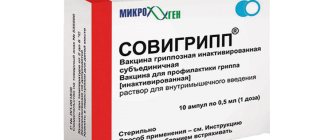Detailed description of the study
The immune system is a collection of organs and tissues that protect the human body from various diseases - infectious, oncological. Protective mechanisms are implemented with the help of cellular (lymphocytes, macrophages, natural killer cells) and humoral (immunoglobulins) immunity.
Class A immunoglobulins (IgA) are proteins from the gamma globulin fraction that are produced by mature B lymphocytes (plasma cells). IgA is presented in the body in the form of two forms: serum - a monomer, circulates in the blood - and secretory - a dimer, detected on the mucous membranes and their secretions. IgA can be found in saliva, tears, milk, colostrum, bronchial secretions and gastrointestinal tract organs. Class A immunoglobulins do not cross the placenta and are passed from mother to child only through breast milk.
Due to the peculiarities of its structure, secretory IgA is not destroyed by enzymes that break down proteins. IgA is the first line of defense of the mucous membranes of the respiratory tract, gastrointestinal tract and genitourinary system from microorganisms and their waste products.
Serum IgA is able to act as a second line of defense against foreign microorganisms that have penetrated the mucosal barrier into the blood.
The most common form of deficiency of this protein is isolated deficiency of immunoglobulin A - a congenital form of immunodeficiency, occurs with a frequency of 1:700 people. This condition may occur without symptoms, but sometimes manifests itself as:
- Frequent infections of the respiratory tract or digestive tract;
- Autoimmune diseases, especially often in the form of celiac disease, inflammatory bowel disease, systemic lupus erythematosus;
- Allergic diseases of the respiratory tract (rhinitis, bronchial asthma) due to an increased tendency to develop allergies.
The main form of excess IgA levels in the body is clonal gammopathies - conditions when B-lymphocytes degenerate into tumor cells and begin to uncontrollably form immunoglobulins of one (monoclonal gammopathy) or several (polyclonal) classes. The most common type (≈25%) is monoclonal IgA, a type of multiple myeloma. Such patients often report the following symptoms:
- Pain in the bones: ribs, sternum, pelvis, spine, collarbones;
- Spontaneous fractures (develop without external causes);
- Pale skin (anemia);
- Tendency to bleeding;
- Frequent recurrent infections, especially bacterial ones;
- Renal failure: impaired formation and excretion of urine, intoxication of the body with toxic metabolites.
This laboratory test determines the total level of IgA in the blood to assess local humoral immunity and diagnose immunodeficiency conditions.
Also, in addition to the IgA analysis, a comprehensive study of humoral immunity and immune status may be prescribed. When diagnosing multiple myeloma, this test is recommended to be taken together with a test for the detection of abnormal proteins - immunofixation or paraprotein typing in the blood serum.
Rabies vaccine culture concentrated purified inactivated
Dosage regimen and method of administration
The contents of the vaccine ampoule must be dissolved in 1.0 ml of water for injection.
Dissolution time should not exceed 5 minutes. The dissolved vaccine is a clear or slightly opalescent liquid from colorless to light yellow. The dissolved vaccine is injected slowly intramuscularly into the deltoid muscle of the shoulder, for children under 5 years old - into the upper part of the anterolateral surface of the thigh. Injection of the vaccine into the gluteal region is not allowed.
Providing anti-rabies assistance
Anti-rabies care consists of local treatment of wounds, scratches, abrasions, salivation sites and subsequent administration of the COCAV rabies vaccine or, if indicated, the combined administration of rabies immunoglobulin (RAI) and COCAV rabies vaccine.
The interval between the administration of AIH and COCAV is no more than 30 minutes.
Local wound treatment
Local treatment of wounds (bites, scratches, abrasions) and drooling areas should begin immediately or as soon as possible after a bite or injury. It consists of abundantly washing the wound surface for several minutes (up to 15 minutes) with water and soap or another detergent (detergent), or, in the absence of soap or detergent, the injury site is washed with a stream of water.
After this, the edges of the wound should be treated with 70% ethyl alcohol or a 5% alcohol solution of iodine. Sutures should be avoided whenever possible.
Suturing is indicated only in the following cases:
- for extensive wounds - several guiding skin sutures after pre-treatment of the wound;
- for cosmetic reasons (skin sutures on facial wounds);
- suturing of bleeding vessels in order to stop external bleeding.
If there are indications for the use of rabies immunoglobulin, it is used immediately before suturing (see section Dosage of rabies immunoglobulin (RAI)).
After local treatment of wounds (damages), therapeutic and prophylactic immunization is immediately started.
Therapeutic and preventive immunization
Indications. Contact and bites of people by animals with rabies, animals suspected of having rabies, wild or unknown animals.
Contraindications. None.
Pregnancy is not a contraindication.
All persons at risk of contracting rabies are subject to therapeutic and prophylactic immunization. If there are indications for combination treatment, then AIH is first administered and, no more than 30 minutes later, COKAV is administered after it.
Rabies immunoglobulin (RAI)
prescribed as soon as possible after contact with a rabid animal or an animal suspected of having rabies, wild or unknown animals.
Before administering heterologous (equine) rabies immunoglobulin, it is necessary to check the patient’s individual sensitivity to horse protein (see “Instructions for the use of rabies immunoglobulin from horse blood serum, liquid”).
Individual sensitivity is not tested before administration of homologous (human) rabies immunoglobulin. Heterologous anti-rabies immunoglobulin is administered no later than 3 days after the bite, homologous anti-rabies immunoglobulin is administered no later than 7 days after the bite.
Dose of rabies immunoglobulin (RAI). Heterologous (equine) rabies immunoglobulin is prescribed at a dose of 40 IU per 1 kg of body weight.
The volume of administered heterologous rabies immunoglobulin should not exceed 20 ml. Homologous (human) rabies immunoglobulin is prescribed at a dose of 20 IU per 1 kg of body weight.
Administration of rabies immunoglobulin (RAI). As much of the recommended dose of AIH as possible should be infiltrated into the tissue around the wound and deep into the wound.
The unused portion of the drug dose is injected deep intramuscularly into a site other than the rabies vaccine.
Preventive immunization
Indications. For preventive purposes, people who have a high risk of contracting rabies are immunized (laboratory employees working with the street rabies virus; veterinarians; rangers, hunters, foresters; persons performing work on catching and keeping animals and other professional groups).
The vaccine is administered intramuscularly into the deltoid muscle of the shoulder, 1.0 ml on days 0, 7 and 30. Revaccination is carried out once, in a dose of 1.0 ml every year and then every three years.
References
- Histology (introduction to pathology) / ed. E.G. Ulumbekova, Yu.A. Chelysheva, 1997. - P. 528-530 p.
- Encyclopedia of clinical laboratory tests / ed. WELL. Titsa. - M.: Labinform, 1997. - P. 213-215, 223-226.
- Histology (introduction to pathology) / ed. E.G. Ulumbekova, Yu.A. Chelysheva. - M.: GEOTAR-Media, 1997. - P. 528 – 530.
- Kumar, V., Abbas, A., Fausto, N. et al. Robbins and Cotran Pathologic Basis of Disease, 2014. - 1464 p.
- Chao, Y., Rötzschke, O., Tan, E. The role of IgA in COVID-19. Brain Behav Immun., 2022. - Vol. 87. - P. 182-183.
HUMAN IMMUNOGLOBULIN ANTI-RHESUS solution for injection. 300 mcg amp. 1 ml No. 1
Directions for use and doses
Intramuscularly.
1 dose (1500 IU) or 2 doses (3000 IU) once: to a postpartum woman within 72 hours after birth, in case of termination of pregnancy immediately after the end of the operation. The following criteria must be met:
- the mother must be Rh negative and must not already be sensitized to the Rh0(D) factor,
- her child must be Rh positive.
If the drug is administered before delivery, it is important that the mother receives 1 additional dose of the drug after the birth of the Rh-positive baby within 72 hours after birth. If it is determined that the father is Rh negative, there is no need to administer the drug.
Before administration, syringes with the drug are kept for 2 hours at room temperature (20±.2 C). In order to avoid the formation of foam, the drug is drawn into a syringe with a wide-bore needle.
The drug cannot be administered intravenously!
For prophylaxis in the postpartum period, 1 dose (1500 IU) of HyperROU S/D should be administered within the first 72 hours after birth. The need for a certain dose in the case of a full term pregnancy varies depending on the volume of fetal blood entering the mother's bloodstream. 1 dose (1500 IU) contains a sufficient amount of antibodies to prevent sensitization to the Rh factor, if the volume of fetal red blood cells entering the bloodstream does not exceed 15 ml. In cases where more fetal red blood cells (more than 30 ml of whole blood or more than 15 ml of red blood cells) are expected to enter the maternal circulation, fetal red blood cells should be counted using an approved laboratory technique (for example, a modified Kleihauer acid wash-stain method and Bethke) to establish the required dose of the drug. The calculated volume of fetal red blood cells entering the mother's bloodstream is divided by 15 ml and the number of doses of HyperROU S/D that must be administered is obtained. If the presence of more than 15 ml of fetal red blood cells is expected or the dose calculation results in a fractional number, the number of doses should be rounded up to the next whole number, for example, if a result of 1.4 is obtained, 2 doses (3000 IU) of the drug should be administered.
For prophylaxis during the prenatal period, 1 dose of the drug (1500 IU) should be administered at approximately the 28th week of pregnancy. Then it is necessary to administer 1 more dose (1500 IU), preferably within 72 hours after birth, if the born child is Rh positive.
If pregnancy continues after the threat of abortion arises, at any stage of pregnancy, 1 dose (1500 IU) of the drug should be administered. If it is suspected that more than 15 ml of fetal red blood cells have entered the maternal bloodstream, the dose must be adjusted (as indicated above).
After spontaneous abortion, induced abortion or termination of an ectopic pregnancy during pregnancy more than 13 weeks, it is recommended to administer 1 dose (1500 IU) of the drug. If it is suspected that more than 15 ml of fetal red blood cells have entered the maternal bloodstream, the dose must be adjusted (as indicated above). If the pregnancy is terminated at less than 13 weeks, a single mini-dose of HyperROU S/D (approximately 250 IU) may be administered.
After amniocentesis at the 15-18th week of pregnancy or during the third trimester of pregnancy, or if an injury to the abdominal organs occurs during the second and/or third trimester of pregnancy, 1 dose (1500 IU) of the drug should be administered. If more than 15 ml of red blood cells are suspected of entering the mother's bloodstream, the dose must be adjusted as described above. If abdominal trauma, amniocentesis, or other adverse circumstance requires administration of the drug at 1318 weeks of gestation, an additional 1 dose (1500 IU) should be administered at 2628 weeks.
To maintain protection throughout pregnancy, the concentration of passively obtained antibodies to Rh0(D) should not fall below the level necessary to prevent an immune response to Rh-positive red blood cells. T1/2 of human anti-rhesus immunoglobulin Rh0(D) is 2326 days. In any case, the dose of the drug should be administered within 72 hours after birth if the baby is Rh positive. If delivery occurs within 3 weeks of the last dose, the postpartum dose can be discontinued (unless more than 15 ml of fetal red blood cells have entered the maternal circulation).




